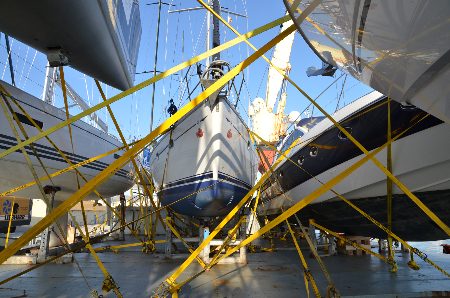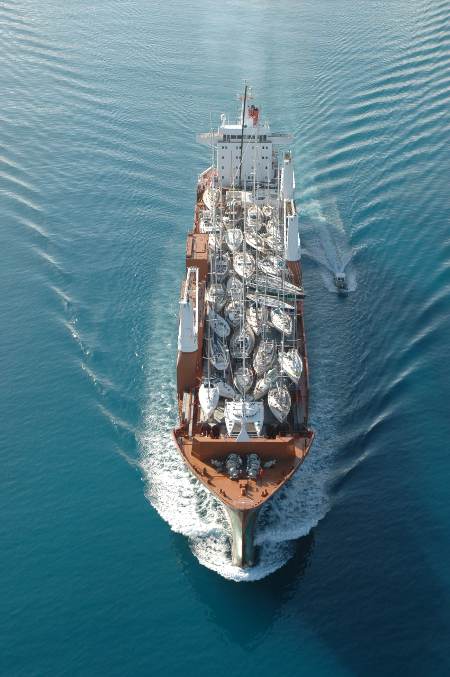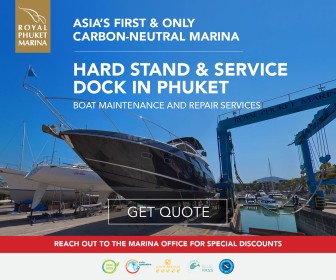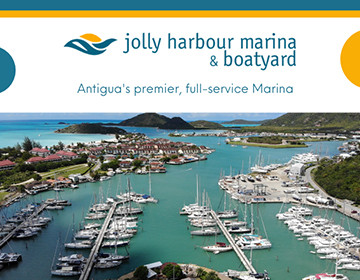Yacht Transport by Carrier Vessel: A Step-by-Step Guide
While transporting a yacht via a carrier vessel ensures a hassle-free and efficient transfer, proper preparation is crucial to ensure the safety and integrity of your prized possession. This article will guide you through the steps involved in preparing your yacht for transport on a vessel.
Published 1 year ago
In the first article about yacht transport, we discussed why you might want to consider this form of delivering your yacht to new cruising grounds, where yacht transport operates, the advantages, frequently asked questions, the costs and how to select a reputable company to handle the shipping for you.
In this second article we guide you through the steps involved in preparing your yacht for transport on a vessel.
Preparing as if for heavy weather
Think of preparing your yacht for heavy weather, or for winterizing it. If you stop for a season at home, you empty your tanks, clean and make everything tidy down below and remove loose items on deck, including taking the sails off. When your yacht is on a transport vessel it will be exposed to the elements, like it will be at sea in a storm.
Your yacht will be securely stowed on deck, high above the rolling axis of the vessel. The big ship is moving at its speed and just 20-25 knots of wind on the nose can result in 40 knots of wind over the deck, lasting for perhaps 10 days. This is not a problem for a yacht, as long as there are no loose items that flap around and everything is well secured.
In general, you need to prepare your yacht as you would for heavy weather in port. By following these guidelines, you can ensure the safe transport of your yacht to its destination.
Pre-Planning
- Collaborating with a reputable yacht transport company and professional loadmasters in the industry will provide you with peace of mind. So, the first step is to conduct thorough research and select a reliable yacht transport company.
Consider their experience, reputation, insurance coverage, and track record. Look for testimonials or seek recommendations from fellow yacht owners. A reputable company will provide professional and valuable guidance and handle the logistics of the transport process. They will also make sure that their local agent gives you a proper brief beforehand so that you fully understand the logistics of yacht transport and how to best-prepare your boat.

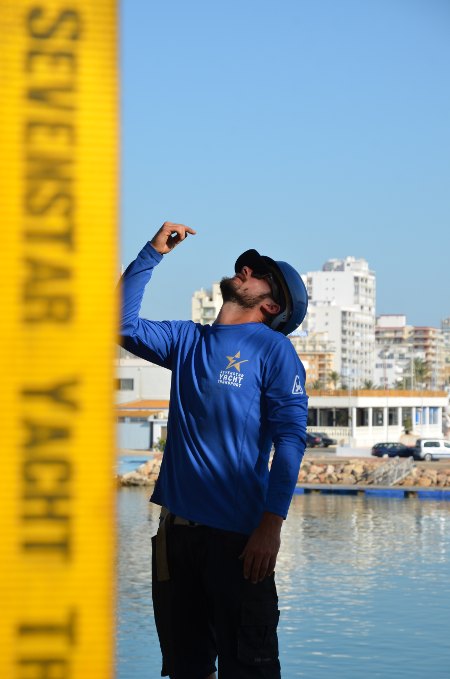
- The best and easiest solution is to choose a logistics partner who provides transport including a proper marine cargo insurance. If you are not sure, you can always ask for the actual insurance clauses and review them yourself, or have them reviewed by your own marine insurance provider. Good logistics partners can also assist you with additional insurances in case you need them, eg. for the delivery of your yacht from the marina to the freighter. Keep copies of the insurance documents readily accessible throughout the transport process.
- Choose a marina to prepare yourself and your yacht with peace of mind, near the commercial port, and allow yourself a few days to properly arrange everything. Where does the loading take place? This differs per port, this can be at anchorage, but also at different terminals. For example, in Baltimore, loading can take place in the paper terminal or in the canton terminal.
Pre-Loading: Preparation in the Marina
- Check the fuel and fluid levels in your yacht. Your yacht should be delivered as lightly as possible. Carry a minimum of fuel on board for the off-loading at the arrival port and make sure your water tanks are empty before you approach the cargo vessel.
- For sailing monohulls, make sure you can remove your backstay quickly and easily if needed. The reason is that when you are on a monohull sailing yacht, backstays have to be removed, otherwise the spreader of the crane can’t get on top of your centre of gravity, which is behind your mast.
Ketch-rigged yachts also have to remove the triadic line between the two masts.
The best is to try this out in the marina or at anchor before you come alongside the vessel.

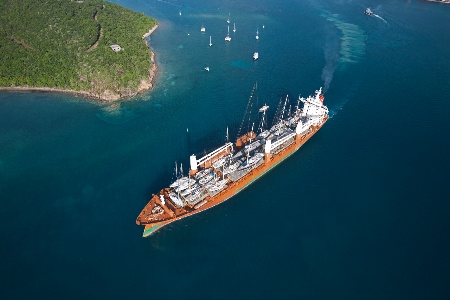
- Ideally remove the genoa, main sail, and any sail covers and store everything inside the yacht. If you choose to keep your mainsail on, make sure it is tightly secured. If a sail cover or other wrapping becomes loose during transport, not only will it be ruined but it can also cause damage to a neighbour’s yacht.
- It is recommended to also take out all halyards and replace them with feeder lines.
- Secure the dinghy tightly, upside-down on deck, so it cannot move an inch. Even better, deflate the dinghy, fold it up, and stow it safely and securely down below with the outboard engine.
- Soft biminis, spray hoods, loose covers, and cushions should all be removed and secured down below.
- To protect deck hardware from salt spray and dust (winches, furling systems, etc.), cover them and tape them off, or protect them with wax or Vaseline.
- For motor yachts, remove or retract long antennas or outriggers.
- Mark lifting points on the hull in a way that both the loadmaster and the diver can see them and possibly mark points where the yacht should not be lifted. Drawings of your yacht will have lifting points shown, or ask the loadmaster who can try and find out. Mark them with a piece of tape.
- Ensure that everything down below is properly secured and stowed away to prevent damage or movement during transport. Lock cabinet doors and for extra security consider taping them to avoid items falling out on the passage. Bear in mind that the yacht will be high on the deck of a ship, so the motion forces are amplified.
- Empty the fridge and freezer, defrost, and clean.
- Remove all valuable items from the yacht.
- Prepare a printed instruction on how to start the engine (and connect batteries, point out switches, etc.) and stick it on your chart table, should there be a need for someone else to start your engine on arrival.
- Label your keys with the yacht’s name. Once you are off your yacht, you can hand over the keys to the loadmaster, and the lifting can start.
- For complete protection, wrapping a boat completely in plastic is possible in many parts of the world. The only effective way is to “melt” a plastic cover over the yacht and then pull a suitable net over it. However this is not recommended for environmental reasons; it may come loose during transport and not only fly into the sea but also damage your yacht as well as your neighbour’s. The cargo vessel’s crew cannot go on deck in all conditions to sort out issues with loose deck gear. Then there’s the problem with disposing of the plastic at the other end.
Handing over the logistics
Once your boat is prepped to this stage, it is possible to leave it in the marina and hand over the remainder of the logistics to the yacht transport company, who have preferred delivery skippers that deal with loading and unloading yachts. This happens a lot in the Caribbean and means you don’t have to hang around should the cargo vessel be delayed.
You only need to set up a meeting with one of the preferred delivery skippers and run through your yacht’s systems. Then you can fly back home and let the delivery skipper take care of your yacht and deal with loading it when the vessel arrives.
Loading: Preparation to come alongside the Carrier Vessel
- Ensure there are at least two people on board the yacht to manage the lines for loading.
- Have some mooring lines available (although normally the ship will throw you lines when you come alongside) and keep a winch handle in the cockpit.
- Hang plenty of fenders. You will need to remove the fenders once your yacht is loaded to avoid scuffing damages. Don’t let them hang on the lifelines during the whole transport.*

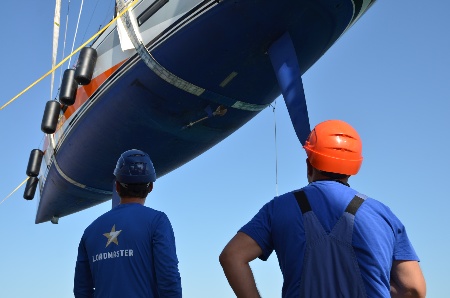
- The loadmaster works with a detailed stowage plan and gives you the loading sequence beforehand. You will be continuously in contact with the agent or operational manager (loadmaster) about your loading date and time. It is recommended to arrive at the carrier vessel an hour before your loading time.
- It is important to arrive at the vessel in plenty of time, however, sometimes there are delays due to weather or operational challenges (but you will be notified about this). When it is raining, loading is still possible unless it interferes with the welding of the yacht cradles. And with too much wind the loading also stops to be safe.
- When the backstay is disconnected it is time to power down your yacht. It’s not enough to just switch off the engine. Make sure you power down everything (especially your AIS) and disconnect the cable to the main batteries. If you don’t, and you have a residual drain, your batteries will be dead at the other end, causing a delay in the discharge of yachts.
- Lock your yacht, step down into the tender – which will be organized by your logistic partner – and hand over the keys to the loadmaster, who’s watching the whole process. When everything looks safe and well, the yacht will be lifted into position on deck. The tender will take all yacht owners from and to the vessel. *On some carriers, yacht owners will be able to board the carrier after loading and tidy away fenders etc. for transport, however, in some ports (Phuket for example) no owners are allowed to board the carrier, so the transport company will be responsible for stowing fenders after loading and reconnecting the backstay (if a monohull). When boarding the carrier vessel you will be required to wear closed shoes with a metal toecap and you will be given a hard hat to wear.

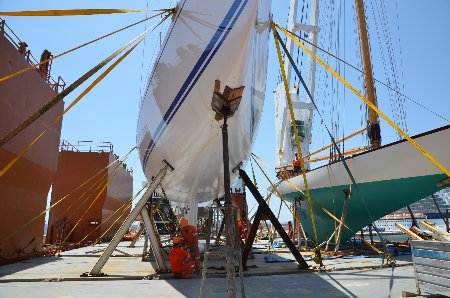
During transport
- During transport you can check on your yacht via AIS and you should get three updates per week by email from your transport company.
- If you are worried about your boat or you forgot to switch something off, you can contact your transport company with your concerns.
Off-loading: What happens on arrival?
- If the carrier vessel remains at anchor on arrival, you will be transferred to the carrier vessel by tender so that you can release the backstay of your yacht for lifting. *Again, if owners are not permitted to board the carrier vessel, this will be done by the transport company.
- Once your yacht is in the water, you will be transferred by tender to your yacht.

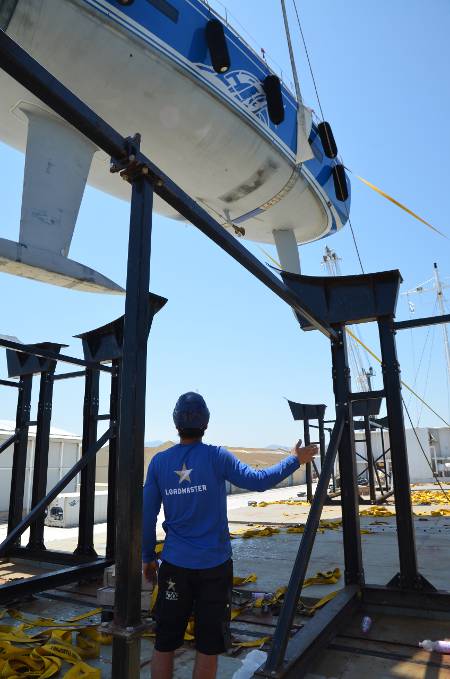
- If the carrier vessel is alongside in port, you will have to come to the terminal and make yourself known to the agent to gain entry approval. You can then board the carrier vessel to deal with your yacht.
- If your engine won’t immediately start once it is back in the water, you must stay alongside the carrier vessel and try to get this fixed. If it takes too long and the ship needs to unload more yachts, or depart, the Agent will order a tug boat at your own cost.
- Your yacht will need a thorough external clean post-transport, because there will always be some dirt and salt. Ideally, book a marina berth for the day of arrival so you can give it a proper clean.
- If your yacht has been damaged during transport you will be notified immediately. If you notice damage on arrival, seek advice from the transport company and the insurance company. The damage must be transport-related damage, so be sure to take photographs as soon as you notice the problem.
- What if you can’t get there to receive your boat? Then you need to advise your transport company in plenty of time and they will try to arrange a skipper for you to collect your yacht and deliver it to your pre-booked marina berth.
Being on time and patient is of the essence for efficient operations. Yacht loading and un-loading only happens when it is 100% safe and sometimes it takes a bit longer before it’s your turn. By following the above step-by-step guidelines, you can properly prepare your yacht for shipping and result in a smooth and carefree passage to the destination port.
………………………………
About the Author
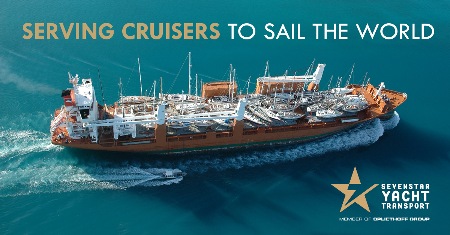

Sevenstar Yacht Transport offers full logistics and yacht transport services for yacht owners looking to discover new destinations around the world. With over 30 years of experience, it arranges the transport of around 2,000 yachts annually – serving cruisers to explore new destinations, to cross the Atlantic, or to just go home. It has an experienced team dedicated to providing high-quality services to clients, with worldwide offices and an in-house team of operations, engineers, and loadmasters.
With access to over 120 company-owned vessels, Sevenstar has the resources and expertise to handle any yachting transport needs. They offer the highest standard of equipment with custom-made cradles (Lloyds certified) and lashing systems to ensure safety during loading, transit, and unloading. For yacht transport solutions, contact Sevenstar Yacht Transport today!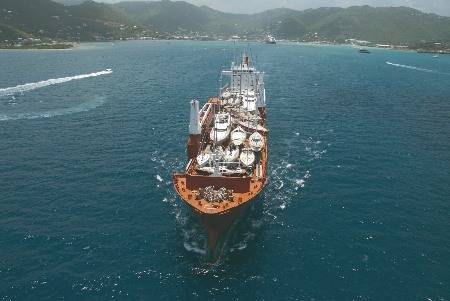

………………………………
Related Links:
- Sevenstar Yacht Transport Instruction Video
- Sevenstar Yacht Transport
- Sevenstar Worldwide Regions and Ports of Operation
- Sevenstar Schedules
- Contact Sevenstar Yacht Transport
………………………………
Related Reports:
- Long distance cruising with Peace of Mind – Article 1
- Other Yacht Transport Articles and Links
- How to Prepare Your Boat for Safe Transport by Road
………………………………
The opinions expressed in this article are the author’s own and do not reflect the view of Noonsite.com or World Cruising Club.
………………………………
Find out all news, reports, links and comments posted on Noonsite, plus cruising information from around the world, by subscribing to our FREE monthly newsletter. Go to https://www.noonsite.com/newsletter/.
Related to following destinations: Antigua, Antigua & Barbuda, Atlantic Coast (France), Auckland, Australia, Australs, Barbuda, British Virgin Islands, Changi, Dubai (Port Rashid), East Coast (USA), Fiji, Florida, France, French Polynesia, Gambiers, Germany, Gibraltar, Gibraltar Port, Greece, Hong Kong, Istanbul, Istanbul Port, La Rochelle, Mahe, Marin, Marquesas, Martinique, Mediterranean Coast (France), Monaco, Monaco, Morocco, Netherlands, New South Wales, New Territories, New Zealand, Newport (Rhode Island), North Island (New Zealand), Phuket Island, Port of Singapore, Port Victoria (Mahe), Portugal, Queensland, San Francisco, Seychelles, Singapore, Society Islands, South Australia, South Coast, Southampton (River Hamble), Southampton (River Itchen), Southampton Water, Spain, St. John's, St. Lucia, St. Martin, Tahiti, Tasmania, Thailand, Tuamotus, Turkey, United Arab Emirates, United Kingdom, USA, Victoria Harbour & Kowloon, West Coast (USA)
Related to the following Cruising Resources: Atlantic Crossing, Caribbean Sea, Circumnavigation, Cruising Information, Global Yachting Services, Indian Ocean, Mediterranean, Pacific Crossing, Planning and Preparation, Routing, Yacht Deliveries, Yacht Transportation





